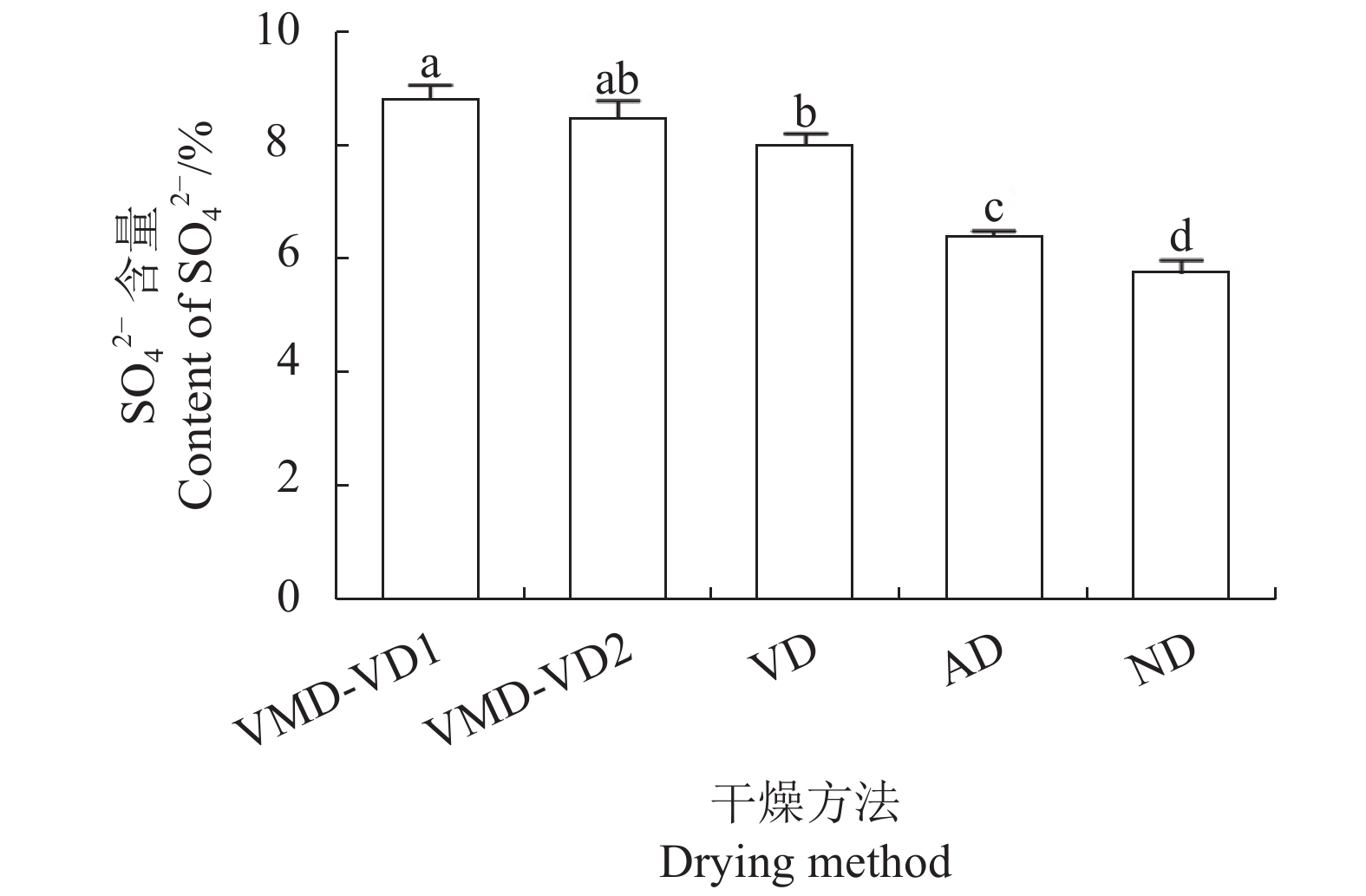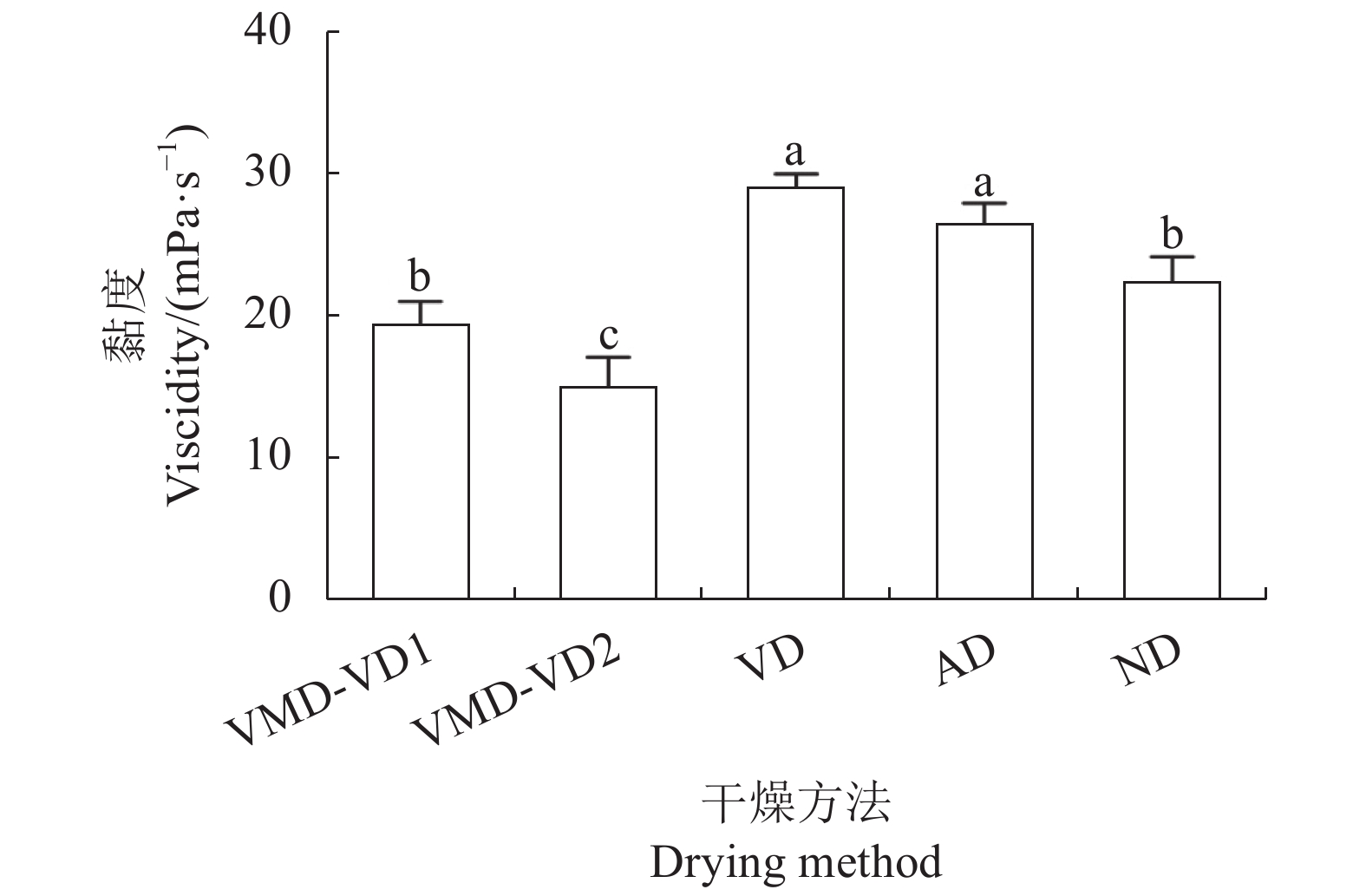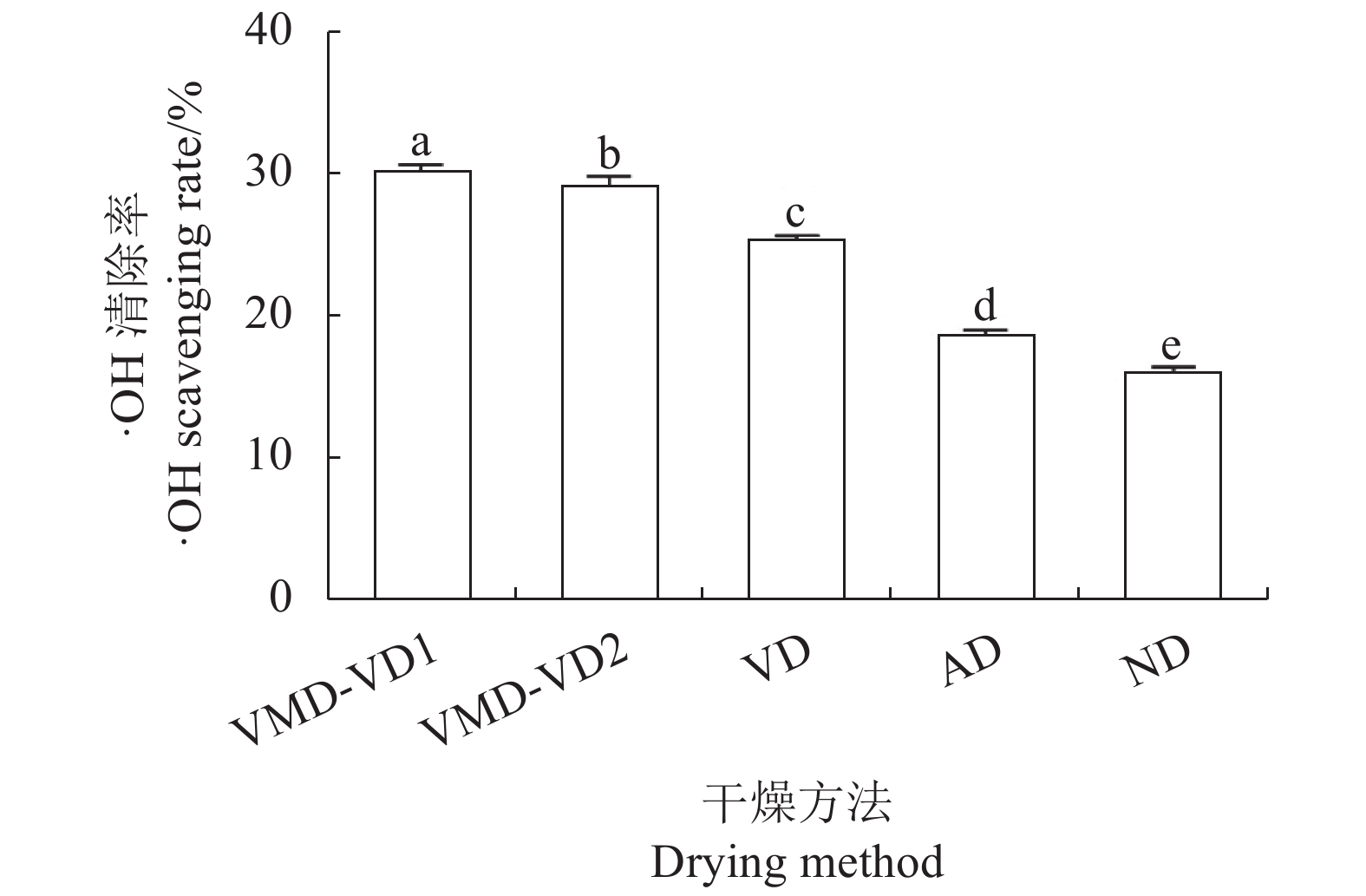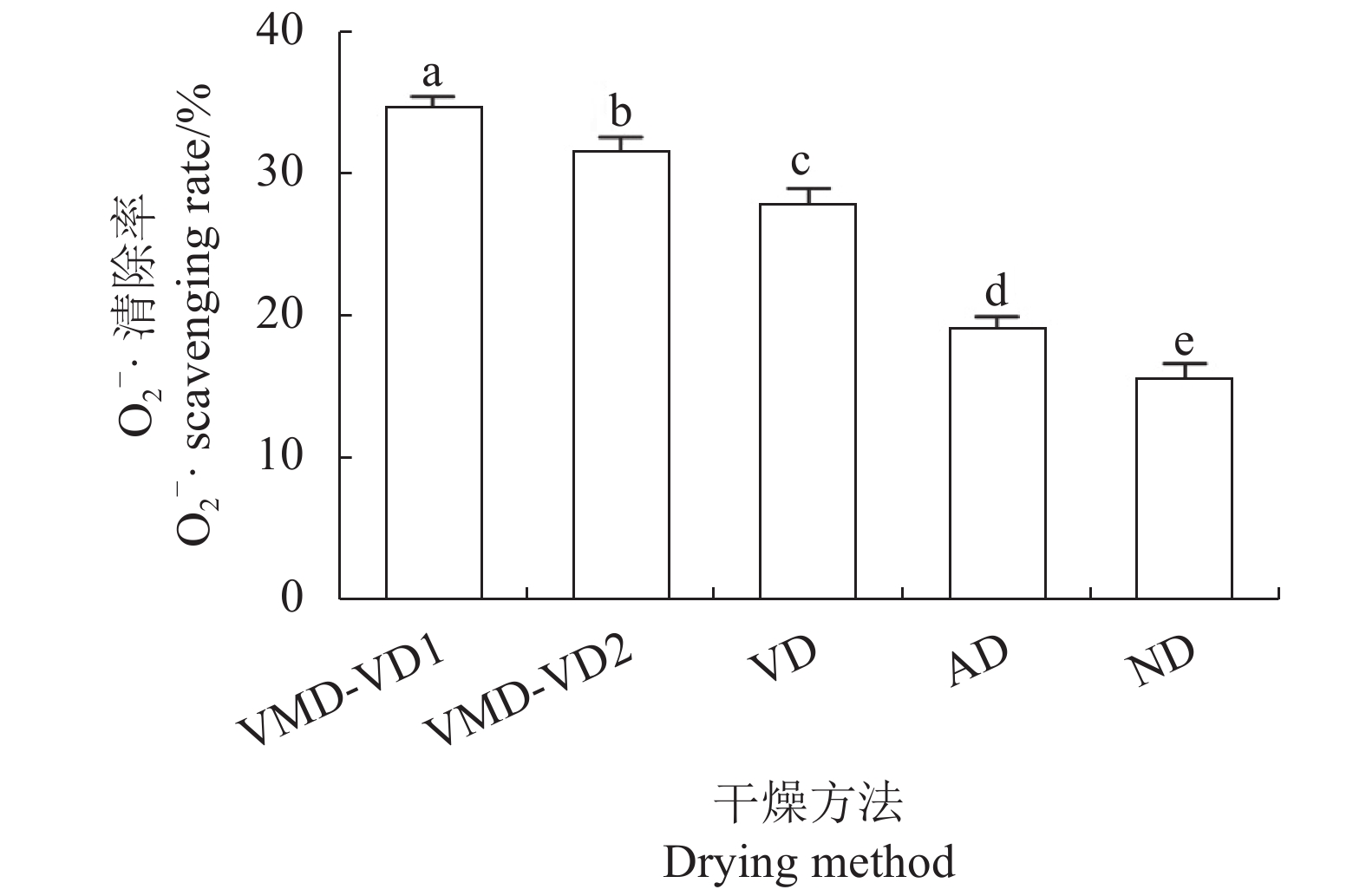Effects of Drying Methods on Content and Properties of Polysaccharides in Laminaria japonica
-
摘要:目的 研究不同干燥方法对海带多糖得率及其部分理化性质的影响,为获取高品质海带干制品提供技术方案。方法 采用2 W·g−1真空微波-真空组合干燥、4 W·g−1真空微波-真空组合干燥、真空干燥、热风干燥和自然日晒5种方法对新鲜海带进行干燥处理,研究不同干燥方法对海带多糖的得率及其SO42−含量、黏度、清除羟自由基和超氧阴离子自由基活性的影响。结果 自然日晒干燥海带的多糖得率(7.87%)、SO42−含量、黏度和体外抗氧化活性显著低于热风干燥和真空干燥样品(P<0.05);两种微波功率密度的真空微波-真空组合干燥海带的多糖得率、SO42−含量和体外抗氧化活性都较高,而其黏度较低,其中4 W·g−1 微波功率密度干燥海带的多糖得率最高(13.83%),而2 W·g−1 微波功率密度干燥海带的多糖体外抗氧化活性最高(P<0.05)。结论 新鲜海带采用不同干燥方法加工会影响海带多糖的得率及其性质,适宜微波功率密度的真空微波-真空组合干燥可以减少海带干燥过程多糖及其体外抗氧化活性的损失,从而提高海带干制品的品质。Abstract:Objective Effects of various dehydration methods on the content and physiochemical properties of polysaccharides in the dried Laminaria japonica were studied.Method Fresh L. japonica was dried by applying 2 W·g−1 microwave-and-vacuum (MV1), 4 W·g−1 microwave-and-vacuum (MV2), vacuum (VD), hot air (HA) or solar exposure (SE). Yield, SO42−, viscosity, scavenging activities on hydroxyl and superoxide anion free radicals of the polysaccharides in the dried kelp were determined.Result Among the tried drying methods, SE produced kelp significantly lower on the yield (i.e., 7.87%), SO42− content, viscosity, as well as the in vitro antioxidant activity of polysaccharides in L. japonica than HA or VD (P<0.05). On the other hand, MV2 rendered dried kelp with the highest polysaccharides content at 13.83%, while MV1 with the greatest antioxidant activity (P<0.05).Conclusion Different drying L. japonica methods resulted in varied properties of the polysaccharides and kelp. By combining microwave and vacuum, the dehydration process maximally retained the functional components and antioxidant activity of the fresh kelp.
-
0. 引言
【研究意义】海带(Laminaria japonica Aresch)又名纶布、昆布,素有“海上之蔬”、“含碘冠军”的美誉,是我国重要的经济海藻,产量位居世界首位[1]。海带虽然价格低廉,但富含碘、甘露醇、维生素A、维生素B族、维生素C、牛磺酸、多糖等功效成分[2],海带含有多种生物活性物质,如海带多糖、昆布氨酸、牛磺酸等,其中海带多糖具有调节免疫、抗肿瘤、抗凝血、抗氧化、降血脂(糖)等独特的功效,在食品、医药、化妆品、农业等方面都具有广阔的应用前景[3-4]。采用自然日晒方法将海带加工成干制品是海带加工的主要方式,但自然日晒方法受自然环境因素的影响,存在易霉变及活性成分损失大等问题,成品品质良莠不齐。因此研发可提高海带干制品质量的现代干燥技术具有重要意义。【前人研究进展】干燥方法会影响干制产品的质量,同样的原料采用不同的干燥方法可以生产出品质完全不同的产品[5]。微波具有穿透性,因此真空微波干燥技术可以有效控制生鲜食品干燥过程的干缩,提高干制品的复水速率和复水比[6],减少多糖等功效成分的损失,并提高其抗氧化活性[7];微波辅助提取技术也可以提高多糖等功效成分的提取率[8];而且不同的微波功率密度对于物料干燥特性和蛋白质等营养成分保留率都有较大的影响[9-10]。【本研究切入点】已有研究表明微波处理可以提高海带多糖的提取率[11],而且真空微波应用于海带干燥加工可以有效改善干制品的复水性等品质指标[6];然而关于干燥加工,特别是不同微波功率密度的真空微波干燥对海带多糖的影响还未见报道。【拟解决的关键问题】本研究采用自然日晒、热风干燥、真空干燥,以及两种不同微波功率密度真空微波-真空组合干燥5种方法对新鲜海带进行干燥,研究不同干燥方法对海带多糖的得率及其特性的影响,旨在为获取高品质海带的干燥方法提供理论依据。
1. 材料与方法
1.1 试验材料
新鲜海带由莆田市后海垦区现代农业发展有限公司提供。
1.2 仪器与设备
RX-16ZK多功能真空微波干燥箱(带电热管加热功能,广州荣兴工业微波设备有限公司产品),DHG-9070A 型电热恒温鼓风干燥箱(上海一恒科技有限公司),NDJ-8S 型数显黏度计(上海菁海仪器有限公司),UV-1900紫外可见分光光度计(上海翱艺仪器有限公司)等。
1.3 试验方法
1.3.1 原料处理
新鲜海带用自来水洗净,切除根部及周边较薄部分,切成1 cm×5 cm规格的海带条,沥去表面水分后用保鲜袋包装,置于5℃冰箱冷藏备用。
1.3.2 干燥试验
(1)2 W·g−1真空微波-真空组合干燥(VM-VD1)
2 000 g鲜海带条以厚度约0.6 cm薄层平铺于带硅胶垫的聚四氟乙烯盘内,在微波功率4 kW、压力−0.085~−0.090 MPa、温度(50±2)℃条件下干燥至海带条含水量30%左右,关闭微波,开启电热管,继续在压力−0.085~−0.090 MPa、电热管功率8 kW、温度(60±2)℃条件下干燥至终点。
(2)4 W·g−1真空微波-真空组合干燥(VM-VD2)
微波功率改为8 kW,其余同1.3.2(1)。
(3)真空干燥(VD)
2 000 g鲜海带条以厚度约0.6 cm薄层平铺于带硅胶垫的聚四氟乙烯网盘上,在压力−0.085~−0.090 MPa、电热管功率8 kW、温度(60±2)℃条件下干燥至终点。
(4)热风干燥(AD)
2 000 g鲜海带条以厚度约0.6 cm薄层平铺于带硅胶垫的聚四氟乙烯网盘上,置于预热到设定温度的恒温鼓风干燥箱内,在温度(60±1)℃、开启鼓风开关的条件下干燥至终点。
(5)自然日晒(ND)
2 000 g鲜海带条以厚度约0.6 cm薄层平铺于带硅胶垫的聚四氟乙烯网盘上,白天置于阳光强烈照射的通风处,夜晚收至室内,晒3 d后至终点。
1.3.3 海带粉制备
海带条水分含量低于8%为干燥终点,将不同干燥方法制备的干海带条粉碎至80目备用。
1.3.4 试验指标及测定方法
(1)海带多糖制备及多糖得率测定
海带多糖的提取参考余华等的方法[12],称取一定重量的海带粉,加25倍蒸馏水于90℃水浴提取6 h,混合液冷却后5 000 r·min−1离心15 min,沉淀中加入海带粉15倍蒸馏水重复提取1次,合并上清液,浓缩至原体积的1/5,加入浓缩液5倍体积的95%乙醇,5℃静置过夜,5 000 r·min−1离心5 min,沉淀冷冻干燥得到海带粗多糖。海带粗多糖用蒸馏水配制成2.0 mg·mL−1的海带粗多糖溶液备用。
多糖含量采用苯酚-硫酸比色法[13]测定。吸取l.0 mL海带粗多糖溶液于具塞试管中,加入1.0 mL 6%苯酚溶液,摇匀后加入5.0 mL浓硫酸,混匀后沸水浴10 min,冷却至室温,于490 nm处测吸光值。以葡萄糖标准品作标准曲线,计算多糖含量。
海带多糖得率(%)=海带粗多糖质量海带干粉质量×多糖含量×100% (2)海带多糖硫酸根含量的测定
采用明胶-氯化钡法测量[14]。称取一定重量的冻干海带粗多糖样品(约20 mg),加入15 mL浓HCl和4.5 mL浓HNO3硝化至微黄色止,消化液定容到50 mL,取2.5 ml硝化液,加入2.5 ml 明胶-氯化钡溶液混匀,静置15 min,于360 nm处测定吸光值。以硫酸钾标准品作标准曲线,计算海带多糖样品中硫酸根含量。
(3)海带多糖黏度的测定
用蒸馏水配制20.0 mg·mL−1的海带粗多糖溶,在20±2℃条件下,选用旋转黏度计2号转子,转速30 r·min−1测定海带多糖黏度。
(4)海带多糖清除羟自由基(·OH)活性的测定
参考孙玉军等的方法[15],在4 mL海带多糖溶液中,分别加入9 mmol·L−1 FeSO4、9 mmol·L−1水杨酸-乙醇溶液和8.8 mmol·L−1 H2O2各0.5 mL,在37℃下反应0.5 h,以蒸馏水代替海带多糖溶液作为空白对照,于510 nm波长处测吸光度值。
清除率计算公式:
⋅OH清除率(%)=A0−AA0×100% 式中:A0
为空白对照管的吸光度值; A为样品管的吸光度值。
(5)海带多糖清除超氧阴离子自由基(O2−·)活性的测定
参考孙玉军等的方法[15],吸取50 mmol·L−1、pH 8.0的Tis-HCl缓冲液4.5 mL,25℃水浴20 min,加入4.0 mL海带粗多糖溶液和0.1 mL 25 mmol·L−1邻苯三酚溶液(以10 mmol·L−1的HCl配制),混匀,25℃反应5 min,加入1 mL 8 mol·L−1HCl终止反应,以Tis-HCl缓冲液代替样品作为空白对照,在300 nm波长处测定吸光度值。
清除率计算公式:
O2−⋅清除率(%)=A0−AA0×100% 式中:A0空白对照管的吸光度值;
A为样品管的吸光度值。
1.3.5 统计分析
所有试验均重复3次,结果取平均值±标准差表示,采用Origin 8.5和SPSS 24软件进行数据处理。
2. 结果与分析
2.1 干燥方法对海带多糖得率的影响
不同干燥方法对海带多糖的得率(图1)有显著影响(P<0.05);多糖得率由小到大的顺序依次为:自然日晒、热风干燥、真空干燥、2 W·g−1真空微波-真空组合干燥、4 W·g−1真空微波-真空组合干燥。即采用自然日晒海带的多糖得率最低,为7.87%;而采用4 W·g−1真空微波-真空组合干燥海带的多糖得率最高,为13.83%。该结果表明,不同干燥方法会显著影响海带多糖的得率,其中自然日晒会导致海带多糖有较大的损失;而较高的微波功率密度(4 W·g−1)有利于提高海带多糖得率。
2.2 干燥方法对海带多糖SO42−含量的影响
不同干燥方法对海带多糖SO42−含量的影响见图2。海带多糖SO42−含量由小到大的顺序依次为:自然日晒、热风干燥、真空干燥、4 W·g−1真空微波-真空组合干燥、2 W·g−1真空微波-真空组合干燥。采用自然日晒海带的多糖SO42−含量最低,为5.71%,明显低于其他方法干燥海带的多糖SO42−含量(P<0.05);而采用2 W·g−1真空微波-真空组合干燥海带的多糖SO42− 含量最高(8.79%),明显高于自然日晒、热风干燥和真空干燥的海带样品(P<0.05),但与4 W·g−1微波功率密度的真空微波-真空组合干燥海带的多糖SO42−含量差异不显著(P>0.05)。
2.3 干燥方法对海带多糖黏度的影响
黏度可以粗略反映出多糖的组分及分子量情况,对于相同浓度的海带多糖溶液,多糖分子量大则其黏度高,反之则低。由图3可以看出,采用真空干燥和热风干燥海带的多糖黏度显著高于自然日晒和两种真空微波-真空组合干燥海带的多糖黏度(P<0.05);而采用4 W·g−1真空微波-真空组合干燥海带的多糖黏度最低。相对热风干燥和真空干燥,自然日晒海带的多糖黏度较低,说明海带在自然日晒过程中其多糖降解率较高;两种真空微波-真空组合干燥海带的多糖黏度较低,而且较高的微波功率密度(4 W·g−1)组合干燥海带的多糖黏度显著低于较低的微波功率密度(2 W·g−1)组合干燥海带的多糖黏度(P<0.05),说明微波干燥会导致海带多糖的降解,而且微波功率密度越高其降解作用越强。
2.4 干燥方法对海带多糖体外抗氧化活性的影响
不同干燥方法对海带多糖清除羟自由基和超氧阴离子自由基活性的影响分别见图4和图5。其清除率由大到小的顺序均为:2 W·g−1真空微波-真空组合干燥、4 W·g−1真空微波-真空组合干燥、真空干燥、热风干燥、自然日晒。该结果表明,干燥方法对海带多糖的体外抗氧化活性有显著的影响(P<0.05);自然日晒会导致海带多糖的体外抗氧化活性大幅降低;相对于热风干燥,真空干燥可减缓海带多糖体外抗氧化活性的损失;真空微波-真空组合干燥海带多糖的体外抗氧化活性较高,而且较高的微波功率密度(4 W·g−1)干燥的海带多糖体外抗氧化活性较低(P<0.05),说明较高的微波功率密度会造成海带多糖体外抗氧化活性的损失。
![]() 图 5 干燥方法对海带多糖清除超氧阴离子自由基(O2−·)能力的影响注:图柱顶部不同小写字母表示处理间差异显著(P<0.05)。Figure 5. Effect of drying methods on superoxide anion radical scavenging activity of polysaccharide in dried L. japonicaNote: Data with different lowercase letters on top of a column indicate significant differences among treatments at P<0.05.
图 5 干燥方法对海带多糖清除超氧阴离子自由基(O2−·)能力的影响注:图柱顶部不同小写字母表示处理间差异显著(P<0.05)。Figure 5. Effect of drying methods on superoxide anion radical scavenging activity of polysaccharide in dried L. japonicaNote: Data with different lowercase letters on top of a column indicate significant differences among treatments at P<0.05.3. 讨论与结论
多糖是生物体内普遍存在的一类生物大分子,具有特殊的生物活性;干燥过程会导致多糖的损失,而且干燥温度越高、时间越长,损失率越高[16]。自然日晒海带的多糖得率、SO42−含量、黏度和体外抗氧化活性低于热风干燥和真空干燥样品,应该是由于受阳光中紫外线及环境中微生物等因素的影响而导致海带多糖发生降解所致。相对于热风干燥,真空干燥可保持海带较低的品温,从而减少多糖的损失;段梦颖等[17]研究也发现真空干燥的聚合草多糖得率、SO42−含量、黏度均高于热风干燥样品。真空微波-真空组合干燥海带的多糖得率、SO42−含量和抗氧化活性较高,而黏度较低,这可能是由于微波干燥时间短,多糖损失少,但微波对多糖具有降解作用所致[18]。对于两种不同微波功率密度的真空微波-真空组合干燥,增大微波功率密度虽然可以提高海带多糖的得率,但也会降低多糖的SO42−含量、黏度和体外抗氧化活性,这是由于较高的微波功率密度对海带细胞结构的破坏作用较强,有利于胞内多糖的溶出[19],从而提高其得率,但也会导致海带多糖因过度降解而损失。
从海带中提取的粗多糖主要包括褐藻胶、褐藻糖胶和褐藻淀粉,其中褐藻糖胶是一种硫酸多糖,也是海带多糖中主要的生物活性成分[20],因此硫酸根含量是考察海带多糖生物活性的重要指标之一[21]。此外,多糖的生物活性与其分子量及其分布有关[22],而黏度可以粗略地反映出多糖的组分及分子量情况。多糖分子量大则黏度高,而黏度过高不利于多糖在体内的扩散和吸收,会降低其生物活性,因此对多糖进行适度降解,有利于提高其生物活性[23]。
真空微波-真空组合干燥技术可以有效减少干燥过程海带多糖的损失,但微波会导致海带多糖的降解,而且微波功率密度越高,其降解作用越强。因此,只有适宜微波功率密度的真空微波-真空组合干燥才是生产高品质海带干制品的有效途径。
-
图 5 干燥方法对海带多糖清除超氧阴离子自由基(O2−·)能力的影响
注:图柱顶部不同小写字母表示处理间差异显著(P<0.05)。
Figure 5. Effect of drying methods on superoxide anion radical scavenging activity of polysaccharide in dried L. japonica
Note: Data with different lowercase letters on top of a column indicate significant differences among treatments at P<0.05.
-
[1] 刘树立, 王春艳, 王华. 我国海带的加工利用和开发 [J]. 食品与药品, 2007, 9(5):34−36. DOI: 10.3969/j.issn.1672-979X.2007.05.012 LIU S L, WANG C Y, WANG H. Utilization and development of Laminaria japonica in China [J]. Foodand Drug, 2007, 9(5): 34−36.(in Chinese) DOI: 10.3969/j.issn.1672-979X.2007.05.012
[2] 李德远, 徐现波, 熊亮, 等. 海带的保健功效及海带生理活性多糖研究现状 [J]. 食品科学, 2002, 23(7):151−154. DOI: 10.3321/j.issn:1002-6630.2002.07.041 LI D Y, XU X B, XIONG L, et al. Review on health function of Laminaria japonica aresch and its biologically active polysaccharides [J]. Food Science, 2002, 23(7): 151−154.(in Chinese) DOI: 10.3321/j.issn:1002-6630.2002.07.041
[3] 张忠山, 张全斌, 王晶, 等. 海带多糖的含量测定方法正确性研究 [J]. 时珍国医国药, 2008, 19(6):1380−1381. DOI: 10.3969/j.issn.1008-0805.2008.06.044 ZHANG Z S, ZHANG Q B, WANG J, et al. Determination for the content of polysaccharides in Laminaria japonica by phenol-vitriolic [J]. LishizhenMedicine and MateriaMedicaResearch, 2008, 19(6): 1380−1381.(in Chinese) DOI: 10.3969/j.issn.1008-0805.2008.06.044
[4] 姚骏, 张弘, 郭森, 等. 海带的生物活性及系列产品开发研究进展 [J]. 食品研究与开发, 2018, 39(8):198−202. DOI: 10.3969/j.issn.1005-6521.2018.08.034 YAO J, ZHANG H, GUO S, et al. The research status of Laminaria japonica areschbiological activity and the development of series product [J]. Food Research and Development, 2018, 39(8): 198−202.(in Chinese) DOI: 10.3969/j.issn.1005-6521.2018.08.034
[5] KROKIDA M K, MARINOS-KOURIS D. Rehydration kinetics of dehydrated products [J]. Journal of Food Engineering, 2003, 57(1): 1−7. DOI: 10.1016/S0260-8774(02)00214-5
[6] 王应强, 张慜. 不同干燥法对脱水-复水海带质量影响的研究 [J]. 食品安全质量检测学报, 2013, 4(4):1274−1280. WANG Y Q, ZHANG M. Effect of different drying methods on quality of dehydrated-rehydrated kelp [J]. Journal of Food Safety and Quality, 2013, 4(4): 1274−1280.(in Chinese)
[7] 衡银雪, 郑旭煦, 殷钟意, 等. 不同干燥方法对黄精干燥特性和品质的影响 [J]. 食品工业科技, 2018, 39(7):158−161, 167. HENG Y X, ZHENG X X, YIN Z Y, et al. The effects of different drying methods on the drying characteristics and quality of Polygonatumodoratum [J]. Science and Technology of Food Industry, 2018, 39(7): 158−161, 167.(in Chinese)
[8] 苏晨曦, 陈文强, 彭浩, 等. 微波辅助提取香菇多糖工艺的响应面优化 [J]. 西北农林科技大学学报(自然科学版), 2015, 43(11):200−206. SU C X, CHEN W Q, PENG H, et al. Response surface optimization of microwave-assisted extraction of polysaccharides from Lentinusedodes [J]. Journal of Northwest A& F University(Natural Science Edition), 2015, 43(11): 200−206.(in Chinese)
[9] 张倩, 张国琛, 母刚, 等. 微波真空干燥对虾夷扇贝闭壳肌营养成分的影响 [J]. 大连海洋大学学报, 2013, 28(6):604−609. DOI: 10.3969/j.issn.2095-1388.2013.06.016 ZHANG Q, ZHANG G C, MU G, et al. Effects of microwave vacuum drying on nutritional quality of yesso scallop adductors [J]. Journal of Dalian Fisheries University, 2013, 28(6): 604−609.(in Chinese) DOI: 10.3969/j.issn.2095-1388.2013.06.016
[10] 毛志幸, 孙辉, 陈宗道. 白果微波干燥特性及干燥动力学模型研究 [J]. 食品工业科技, 2017, 38(22):18−23+28. MAO Z X, SUN H, CHEN Z D. Study on the microwave drying characteristics and drying kinetics model of Ginkgo buoba [J]. Science and Technology of Food Industry, 2017, 38(22): 18−23+28.(in Chinese)
[11] 田洪芸, 王洪新, 戴易兴, 等. 超声-微波协同辅助提取海藻酸钠的工艺条件 [J]. 食品与生物技术学报, 2012, 31(2):217−223. DOI: 10.3969/j.issn.1673-1689.2012.02.017 TIAN H Y, WANG H X, DAI Y X, et al. The extraction process of sodium alginate aassisted by ultrasound-microwave [J]. Journal of Food Science and Biotechnology, 2012, 31(2): 217−223.(in Chinese) DOI: 10.3969/j.issn.1673-1689.2012.02.017
[12] 余华. 海带多糖提取条件的优化和脱蛋白研究 [J]. 中国食品添加剂, 2006(3):39−43. DOI: 10.3969/j.issn.1006-2513.2006.03.008 YU H. Study on the extracting condition and deproteinization of Laminaria japonica aresch polysaccharide [J]. China Food Additives, 2006(3): 39−43.(in Chinese) DOI: 10.3969/j.issn.1006-2513.2006.03.008
[13] SUCHKOV V V, POPELLO I A, GRINBERG V Y, et al. Isolation and purification of 7S and 11S globulins from broad beans and peas [J]. Journal of Agricultural and Food Chemistry, 1990, 38(1): 92−95. DOI: 10.1021/jf00091a017
[14] 张惠芬, 樊建, 束嘉秀, 等. 硫酸-蒽酮分光光度法测定SPS的方法研究 [J]. 昆明理工大学学报(理工版), 2002, 27(3):74−77, 83. ZHANG H F, FAN J, SHU J X, et al. Investigation of methodology on determination of polysaccharide content in SPS by spectrophotometric analysis of H2SO4-anthrone coloration [J]. Journal of Kunming University of Science and Technology(Natural Science Edition), 2002, 27(3): 74−77, 83.(in Chinese)
[15] 孙玉军, 陈彦, 王松华, 等. 胡萝卜多糖体外抗氧化活性研究 [J]. 热带作物学报, 2011, 32(03):403−406. SUN Y J, CHEN Y, WANG S H, et al. Study on antioxidant activity of polysaccharides from carrot (Daucuscarota var. sativa) in vitro [J]. Chinese Journal of Tropical Crops, 2011, 32(03): 403−406.(in Chinese)
[16] 赵云青, 黄颖桢, 陈菁瑛, 等. 不同干燥温度对金线兰品质与有效成分的影响 [J]. 福建农业学报, 2017, 32(07):807−809. ZHAO Y Q, HUANG Y Z, CHEN J Y, et al. Quality and functional ingredients of Anoectochilusroxburghii(Wall.) Lindl. dried at various dehydration temperatures [J]. Fujian Journal of Agricultural Sciences, 2017, 32(07): 807−809.(in Chinese)
[17] 段梦颖, 刘坤, 尚红梅, 等. 干燥方式对聚合草多糖理化性质和抗氧化活性的影响 [J]. 西北农林科技大学学报(自然科学版), 2018, 46(10):8−14. DUAN M Y, LIU K, SHANG H M, et al. Effects of drying methods on physicochemical properties and antioxidant activities of polysaccharides from Symphytumofficinale L [J]. Journal of Northwest A& F University(Natural Science Edition), 2018, 46(10): 8−14.(in Chinese)
[18] 任瑞, 马海乐, 朱春梅, 等. 香菇多糖微波降解反应动力学研究 [J]. 化学工程, 2009, 37(4):41−43. DOI: 10.3969/j.issn.1005-9954.2009.04.012 REN R, MA H L, ZHU C M, et al. Kinetics of microwave degradation of lentinan [J]. Chemical Engineering, 2009, 37(4): 41−43.(in Chinese) DOI: 10.3969/j.issn.1005-9954.2009.04.012
[19] 刘琳, 宋丽敏. 桦褐孔菌发酵液中三萜化合物和多糖的微波辅助双水相萃取 [J]. 食品与发酵工业, 2016, 42(5):246−252. LIU L, SONG L M. Microwave-assisted aqueous two-phase system extraction of triterpenoids and polysaccharides in Inonotusobliquus fermentation broth [J]. Food and Fermentation Industries, 2016, 42(5): 246−252.(in Chinese)
[20] 程斌. 海带硫酸多糖的提取纯化降解及活性研究[D]. 曲阜: 曲阜师范大学, 2009. CHENG B. Study on extraction, purification, degradation and activity of sulfated polysaccharide from Laminaria japonica[D]. Qufu: Qufu Normal University, 2009.(in Chinese)
[21] WANG J, ZHANG Q B, ZHANG Z S, et al. Antioxidant activity of sulfated polysaccharide fractions extracted from Laminaria japonica [J]. International Journal of Biological Macromolecules, 2008, 42(2): 127−132. DOI: 10.1016/j.ijbiomac.2007.10.003
[22] 封聚强, 赵骏. 中药多糖的分子量及结构研究进展 [J]. 时珍国医国药, 2008, 19(3):624−625. DOI: 10.3969/j.issn.1008-0805.2008.03.054 FENG J Q, ZHAO J. Advancement on molecular weight and constitution of polysaccharide of traditional Chinese drug [J]. Lishizhen Medicine and Materia Medica Research, 2008, 19(3): 624−625.(in Chinese) DOI: 10.3969/j.issn.1008-0805.2008.03.054
[23] TABATA K, ITO W, KOJIMA T, et al. Ultrasonic degradation of schizophyllan, an antitumor polysaccharide produced by Schizophyllum commune Fries [J]. Carbohydrate Research, 1981, 89(1): 121−135. DOI: 10.1016/S0008-6215(00)85234-9
-
期刊类型引用(4)
1. 胡顺强,郑恩萍,赵婷雪,任诗雅,李杨,杨海龙. 褐藻活性成分制备及其稳定性研究进展. 浙江农业科学. 2023(08): 2018-2027 .  百度学术
百度学术
2. 郭赛飞,周荣,沈建,欧阳杰,马田田,白贞. 海带晾晒干燥特性及干燥模型研究. 渔业现代化. 2022(01): 97-105 .  百度学术
百度学术
3. 李琪,王琤韡. 柠檬酸提取法中液料比对海带多糖提取率的影响及其保湿性研究. 粮油与饲料科技. 2022(01): 17-19+28 .  百度学术
百度学术
4. 叶晗,李炎鑫,赵梦瑶,赵黎明. 热风干燥海带含水量近红外光谱预测模型建立及品质评价. 食品科技. 2022(10): 252-259 .  百度学术
百度学术
其他类型引用(2)







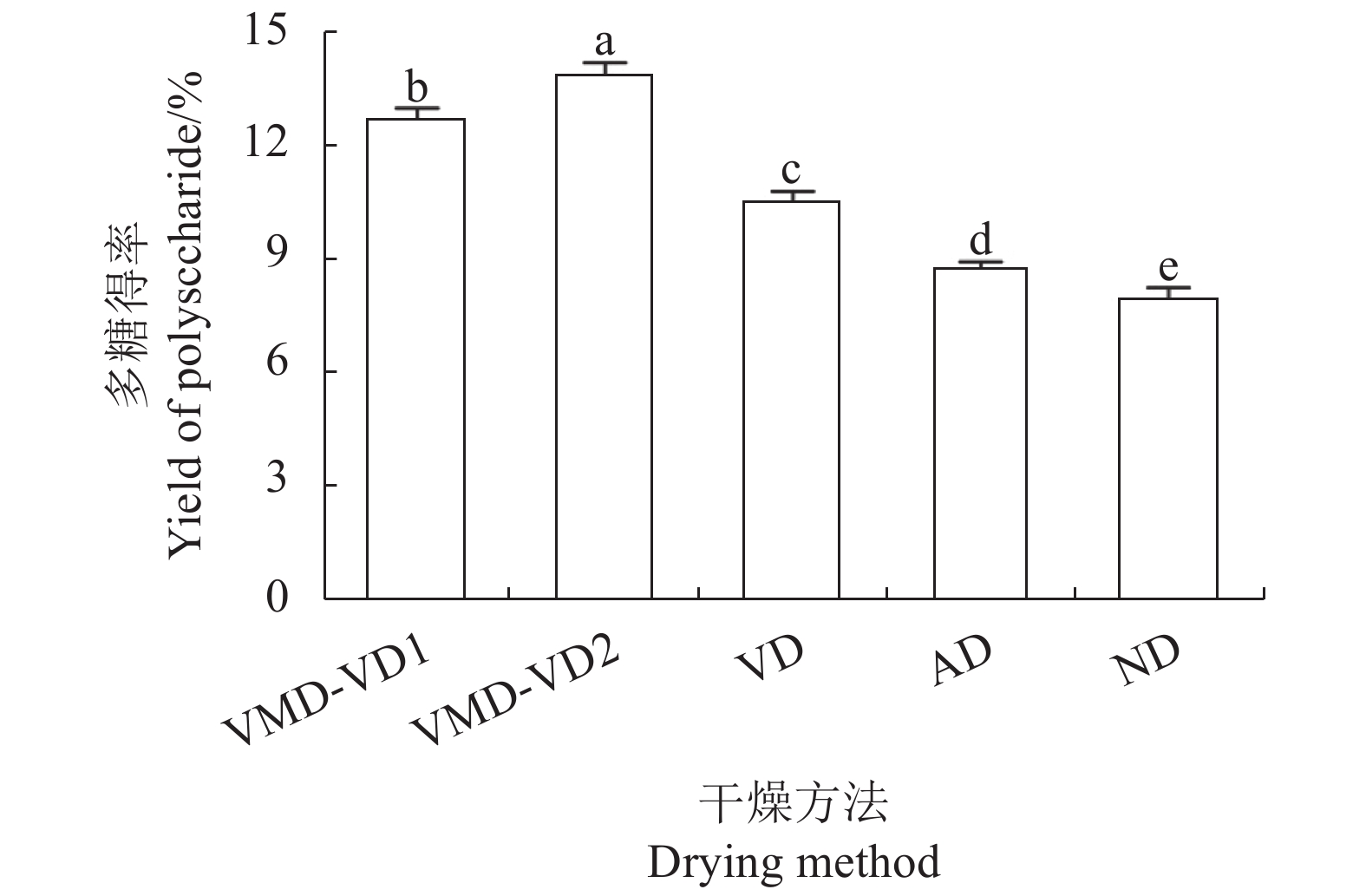
 下载:
下载:
